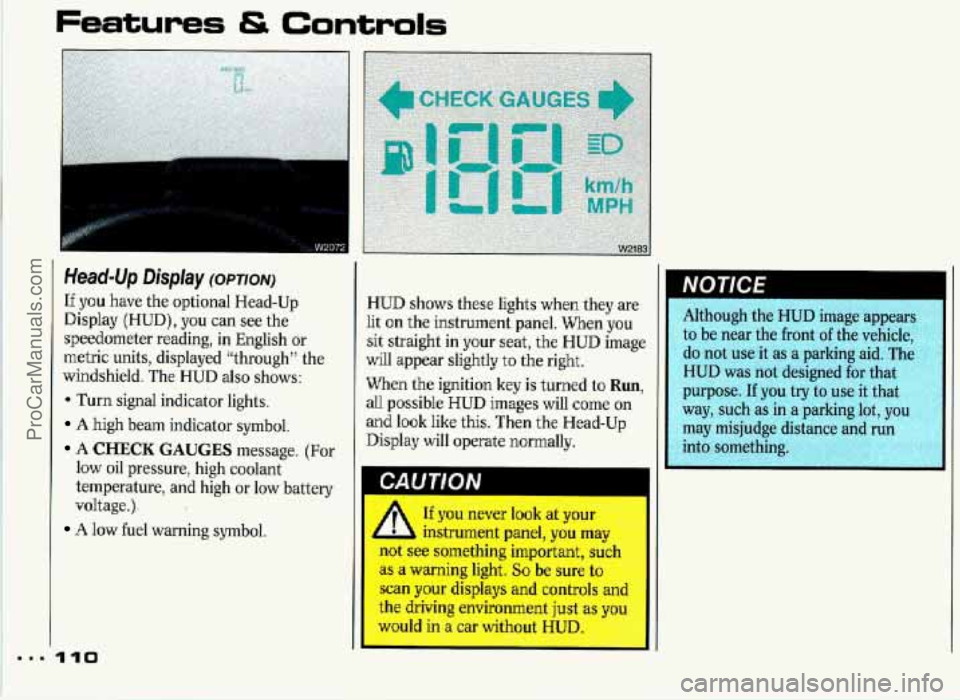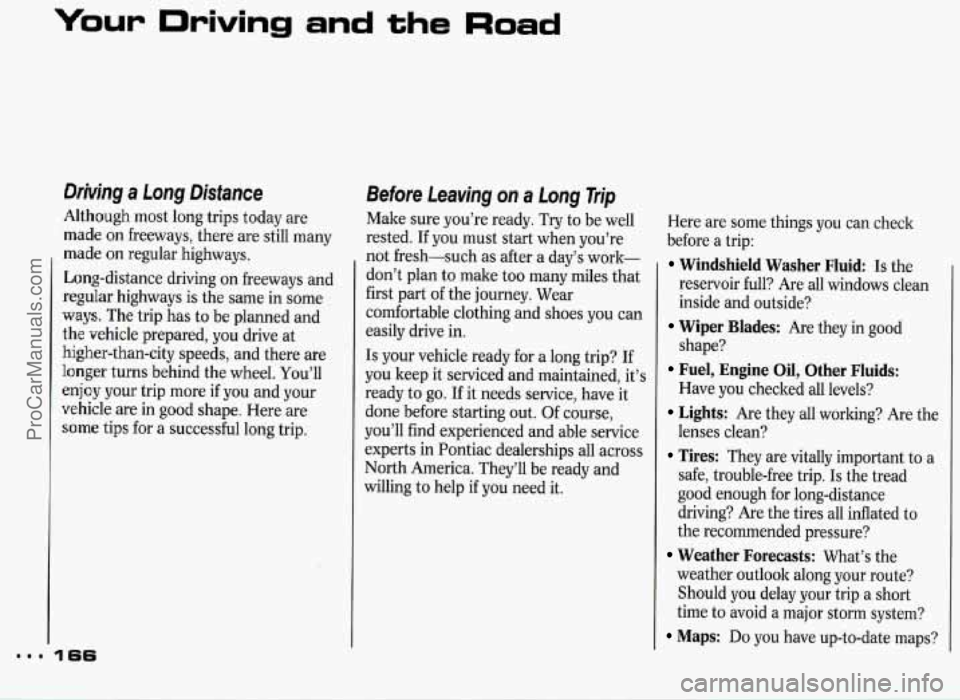1993 PONTIAC GRAND-PRIX fuel pressure
[x] Cancel search: fuel pressurePage 7 of 338

How to Use this Manual
Vehicle Symbols (CQNT.)
These symbols are on some of your
controls:
Windshield
WiperlWasher
Windshield Defroster
Rear Window Defogger
Ventilating Fan
Power Window
These symbols are used on warning and
indicator lights:
Engine Coolant - Fd
Temperature .HccF
Battery Charging
System
Fuel
Engine Oil Pressure
Brake
Anti-Lock Brakes
Here are some other symbols you may
see:
Fuse
Trunk Release
Lighter
Horn
Speaker
Hood Release
ProCarManuals.com
Page 105 of 338

Features & Controls
Malfunction Incfkator Lamp
(Semite Engine Soon Light)
A computer monitors operation of your
fuel, ignition and emission control
systems. This light should
come on
when the ignition is on, but the engine
is not running, as a check to show you
it is,
working. If it does not come on at
all, have it fixed right away. If it stays
on, or it comes on while you are driving,
the computer is indicating that yo8u
have a problem. You should take your
vehicle in for service soon.
If you keep driving your vehicle
with
this light on, after a while th
emission controls won't work as
well, your fuel economy won't be
as good and your engine may not
run as smoothly. This could lead to
costly repai+p@,cqered
by your warranty :',~: ~;'='-- ~ -'--:< .:-
Check Gauges Light (OPTION)
The CHECK GAUGES light will come
on
if your oil pressure gage or engine
coolant temperature gage
is pointing to
the red area.
If these gages do not indicate a
problem, the CHECK GAUGES light
means there is
a problem with your
vehicle's charging system.
ProCarManuals.com
Page 111 of 338

Features & Controls
Head-Up Display (OPTION)
If you have the optional Head-Up
Display (HUD), you can see the
speedometer reading,
in English or
metric units, displayed “through” the
windshield. The HUD
also shows:
* Turn signal indicator lights.
A high beam indicator symbol.
A CHECK GAUGES message. (For
low oil pressure, high coolant
t.emperature, and high or low battery
voltage.).
A low fuel warning symbol.
HUD shows these lights when they are
lit on the instrument panel. When you
sit straight in your seat, the HUD image
will appear slightly to the right.
When the ignition key
is turned to Run,
all possible HUD images will! come on
and look like this. Then the Head-Up
Display will operate normally. Although
the HUD image appears
to be near the front
of the vehicle,
do not use it as a parking aid. The
HUD was
not designed for that
purpose.
If you try to use it that
way, such as in a parking lot, you
may misjudge distance and run
r,y, into something. R
A If you never look at your
,A instrument panel, you rnL
not see something important, si1
as a warning light. So be sure tc
scan your displays and controls
an
th’e driving environment ju,st as xou --. W n a car w- out UD. .:g:~$ I. A,..+-
.- -. rA .-
ProCarManuals.com
Page 167 of 338

Your Driving and the Road
Drkjng a Long Distance
Although most long trips today are
made on freeways, there are still many
made
on regular highways.
Long-distance driving on freeways and
reguIar highways is the same in some
ways. The trip has to be planned and
the vehicle prepared, you drive at
higher-than-city speeds, and there are
longer turns behind the wheel. You’ll
enjoy your trip more if you and your
vehicle are in good shape. Here are
some tips for a successful long trip.
Before Leaving on a Long Trip
Make sure you’re ready. Try to be well
rested. If you must start when you’re
not fresh-such as after a day’s work-
don’t plan to make too many miles that
first part of the journey. Wear
comfortable clothing and shoes you can
easily drive in.
Is your vehicle ready for a long trip? If
you keep it serviced and maintained, it’s
ready to go. If it needs service, have it
done before starting out. Of course,
you’ll find experienced and able service
experts in Pontiac dealerships all across
North America. They’ll be ready and
willing to help
if you need it. Here
are some things you can check
before a trip:
Windshield Washer Fluid Is the
reservoir full? Are all windows clean
inside and outside?
shape?
Have you checked all levels?
lenses clean? safe, trouble-free trip.
Is the tread
good enough for long-distance
driving? Are the tires all inflated to
the recommended pressure?
weather outlook along your route?
Should
you delay your trip a short
time to avoid a major storm system?
Maps: Do you have up-to-date maps?
Wiper Blades: Are they in good
Fuel, Engine Oil, Other Fluids:
Lights: Are they all working? Are the
Tires: They are vitally important to a
Weather Forecasts: What’s the
ProCarManuals.com
Page 253 of 338

aam
Service & Appearance Care
Windshield Wiper Blade
Replacement
Replacement blades come in different
types and are removed in different
ways. Here’s how to remove the type
with
a release clip:
1. Pull the windshield wiper arm away
2. Lift the release clip with a
from the
windshield.
screwdriver and pull the blade
assembly off the wiper arm.
the wiper arm.
3. Push the new wiper blade securely on
252
Loading Your Vehicle
Two labels on your vehicle show how
much weight it may properly carry. The
Tire-Loading Information label found
on the inside of the trunk lid tells you
the proper size, speed rating and
recommended inflation pressures for
the tires on your vehicle. It also gives
you important information about the
number of people that can be in your
vehicle and the total weight that you
can carry. This weight is called the
Vehicle Capacity Weight and includes
the weight of all occupants, cargo, and
all nonfactory-installed options.
The other label is the Certification label,
found on the rear edge of the driver’s
door. It tells you the gross weight
capacity of your vehicle, called the GVWR
(Gross Vehicle Weight Rating).
The GVWR includes the weight of the
vehicle, all occupants, fuel and cargo.
Never exceed the GVWR for your
vehicle, or the Gross Axle Weight
Rating (GAWR) for either the front or
rear axle.
And,
if you do have a heavy load, you
should spread it out. Don’t carry more
than
167 lbs. (75 kg) in your trunk.
ProCarManuals.com
Page 300 of 338

Section B: Owner Checks & Services
Listed below are owner checks and services which should be
performed at the intervals specified to help ensure the
safety, dependability and emission control performance of
your vehicle. Be
sure any necessary repairs are completed at once.
Whenever any fluids or lubricants are added
to your vehicle,
make sure they are the proper ones, as
shown in Section D.
At Each Fuel Fill (It is important for you or a sewice station attendant to perform these underhood checks at each fue\
l fill..)
CHECK
OR SERVICE WHAT TO DO
i
I Engine Oil Level
Check the engine oil level and add
the proper oil if necessary. See the Index under Engine Oil for
further details.
I
Engine Coolant Level Check the engine coolant level in the coolant recovery tank and add the proper coolant mix if
I necessary. See the Index under Coolant for further details.
Windshield Washer See the
Index under Windshield Washer Fluid for further details.
Fluid Level Check the windshield washer fluid level in
the windshield washer tank and add fluid
if necessary.
At Least Once a Month h
CHECK
OR SERVICE WHAT TO DO
Tire Inflation
Check tire inflation. Make
sure they are inflated to the pressures specified on the Tire-Loading
Information label located on the rear edge of the driver’s door or inside the trunk lid. See the
Index under Tires for further details.
At Least Twice a Year h I CHECK
OR SERVICE WHAT TO DO
Hydraulic Clutch
in this system could indicate a problem. Have the system inspected and repaired at once.
System Inspection Check the fluid level in
the clutch reservoir. See the Index under Hydraulic Clutch. A fluid loss
ProCarManuals.com
Page 332 of 338

..
Net. Convenience ............................. 50
New Vehicle Break-In ................ 51. 175
Night Driving
................................... 157
Octane Requirements
Odometer
........................................... 96
Off-Road Recovery
........................... 154
Oil Change Indicator
........................ 107
Oil. Engine
........................................ 220
Capacity
.......................................... 276
Change. Distance to
....................... 107
Quality
........................................... 22 1
Thickness ...................................... 222
Used Oil
.......................................... 223
When to Change
.................... 107. 223
Oil Warning Light
............................. 100
Operation
of Lights ............................. 78
Outside Rearview Mirrors ................. 83
Overdrive. Automatic ................... 57. 60
Overheated Engine Coolant Warning Light
................................. 98
Owner Checks
& Services ............... 299
(see
Fuel
Requirements)
Overheated Engine .......................... 193 Paint
Chemical Spotting
......................... 268
Finish Care
..................................... 266
Finish Damage
............................... 267
Column Shift
................................... 65
Console Shift
................................... 66
On Hills ......................................... 169
Over Things That Burn
................... 68
With the Engine Running
................ 68
Parking Brake ..................................... 64
Passenger Assist Straps
...................... 89
Passenger Belts (see Safety Belts)
Passing ............................................. 154
Polishing and Waxing
Power Antenna
................................ 135
Power Door Locks
.............................. 46
Power Mirrors
.................................... 84
Power Seat Controls
.......................... 11
Power Steering ................................ 151
Power Steering Fluid
........ 233.277. 279
Power Windows
......................... 70. 275
Park.
Shifting Into
Parking
(see
Appearance Care)
Pregnancy. Use of Safety Belts
During
............................................. 23
Problems
on the Road ..................... 183
Publications (see Service Publications)
Pulse Windshield Wipers .................... 76
Radiator Overheating
(see
Overheated Engine)
Radiator Pressure Cap .............. 197. 232
Radio (see
Audio Systems)
Rain. Driving in the .......................... 159
Reading Lights
.................................... 81
Rear Window Defogger ................... 118
Rearview Mirror .......................... 83, 84
Reclining Seatbacks
............................ 12
Reminder Light
................................... 19
Remote Control Mirrors .................... 84
Remote Lock Control
......................... 46
Remote Positive Battery Terminal
.... 186
Remote Trunk Release
...................... 50
Replacement Bulbs .......................... 280
Replacement Fuses
........................... 271
Replacement Parts
........................... 284
Replacing Brakes
.............................. 235
Replacing Safety Belts
........................ 40
.
ProCarManuals.com